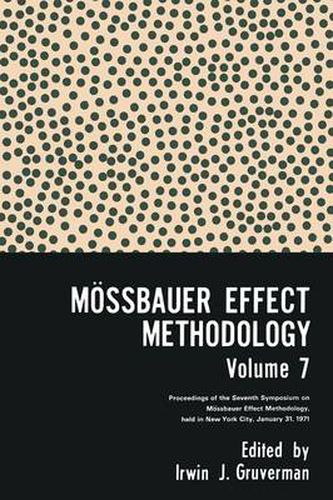Readings Newsletter
Become a Readings Member to make your shopping experience even easier.
Sign in or sign up for free!
You’re not far away from qualifying for FREE standard shipping within Australia
You’ve qualified for FREE standard shipping within Australia
The cart is loading…






This title is printed to order. This book may have been self-published. If so, we cannot guarantee the quality of the content. In the main most books will have gone through the editing process however some may not. We therefore suggest that you be aware of this before ordering this book. If in doubt check either the author or publisher’s details as we are unable to accept any returns unless they are faulty. Please contact us if you have any questions.
This is the seventh volume of a series that provides a continuing forum for publication of developments in Wdssbauer effect methodology and in spectroscopy and its applications. Wdssbauer Effect Methodology, Volume 7, records the proceedings of the Seventh Symposium on Wdssbauer Effect Methodology. The symposium was sponsored by the New England Nuclear Corporation and interest was concentrated on spec troscopy, with some attention to methodology and applica tions. The Symposium was held in the Mercury Ballroom of the New York Hilton on January 31, 1971. Dr. N. Benczer Koller presided over the afternoon and evening sessions. About two hundred participants attended, demonstrating the continued high level of effort in the field and of interest in this series. Austin Science Associates, Elron, and Nuclear Science Instruments demonstrated their Wdssbauer equipment products. These were well received, and evidently are continuing to improve in utility and quality. Applications papers reported on local magnetic moment measurement and radiation damage studies. A large number of spectroscopy papers was presented and subject matter included work on Mossbauer parameters in iron, tin, and europium and on conversion electron spectroscopy. Method ology work reported included a source for Snl19-Sb12l, a blackness distortion removal technique, and use of radio frequency fields. A paper is included on calculational techniques although it was not ready for presentation at the symposium.
$9.00 standard shipping within Australia
FREE standard shipping within Australia for orders over $100.00
Express & International shipping calculated at checkout
This title is printed to order. This book may have been self-published. If so, we cannot guarantee the quality of the content. In the main most books will have gone through the editing process however some may not. We therefore suggest that you be aware of this before ordering this book. If in doubt check either the author or publisher’s details as we are unable to accept any returns unless they are faulty. Please contact us if you have any questions.
This is the seventh volume of a series that provides a continuing forum for publication of developments in Wdssbauer effect methodology and in spectroscopy and its applications. Wdssbauer Effect Methodology, Volume 7, records the proceedings of the Seventh Symposium on Wdssbauer Effect Methodology. The symposium was sponsored by the New England Nuclear Corporation and interest was concentrated on spec troscopy, with some attention to methodology and applica tions. The Symposium was held in the Mercury Ballroom of the New York Hilton on January 31, 1971. Dr. N. Benczer Koller presided over the afternoon and evening sessions. About two hundred participants attended, demonstrating the continued high level of effort in the field and of interest in this series. Austin Science Associates, Elron, and Nuclear Science Instruments demonstrated their Wdssbauer equipment products. These were well received, and evidently are continuing to improve in utility and quality. Applications papers reported on local magnetic moment measurement and radiation damage studies. A large number of spectroscopy papers was presented and subject matter included work on Mossbauer parameters in iron, tin, and europium and on conversion electron spectroscopy. Method ology work reported included a source for Snl19-Sb12l, a blackness distortion removal technique, and use of radio frequency fields. A paper is included on calculational techniques although it was not ready for presentation at the symposium.